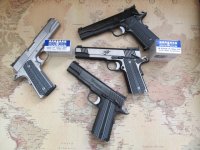I've never owned a 1911 chambered in .40 or 9 (well, I did own a 9, but sold it before shooting it).
But, I have been shooting USPSA and IDPA competition since the mid-'90s, sometimes two or three times a week, for twenty years.
I've watched thousands of shooters at hundreds of matches.
The 1911 already has a reputation of being somewhat fiddly, requiring more care and attention than some modern plastic fantastics, and my observations support the belief that 1911s chambered in the shorter cartridges are more fiddly about magazines, cartridge OAL, extractor tension, etc.
The "problems" aren't different, the newer cartridges just don't have the decades of development that .45 and Super have.
I think the 1911 - 5", Government length - is most reliable in .38 Super, as it is the same length as the round the gun was designed around, and, the cartridge, as it rests in position to feed into the chamber, is closer to the chamber - cartridge centerline and chamber centerline - than larger diameter cartridges, so it doesn't have to zig or zag as much to get into the chamber.
Virtually everyone I knew who was shooting .40 every weekend was long-loading to improve feed reliability - long enough that the rounds wouldn't fit in the mag of a short-stroke gun like a Glock, M&P, etc. - and every year or two a new 9mm magazine comes out, which is supposed to be like a magic wand; if the guns still didn't have chronic problems, why do the mags have to be constantly redesigned?
Completely anecdotal, but I was listening to a professional shooter describe the custom gun she was shooting, and though the company sponsoring her didn't make a gun chambered in .38 Super at the time, her gun had been converted from 9 to Super. She didn't say, "Because the 9 never ran right", but that's what I read into it.
Longer is better.

